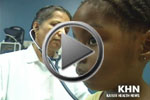To determine the quality of care the nearly 1,200 federally funded health centers provide to more than 20 million people, Kaiser Health News used the U.S. Freedom of Information Act to obtain data showing how individual health centers performed in 2010 based on six patient care measures: controlling blood sugar of diabetics and blood pressure of patients with hypertension, providing pregnant women with prenatal care starting in their first trimester, keeping down the rate of low birth weight babies, screening for cervical cancer and immunizing children.
The U.S. Health Resources and Services Administration (HRSA), which oversees the health centers, has been collecting this data from the center since 2008. The government agency has been reporting on its website how the centers overall performed nationally and by state. It plans to post data on individual centers this summer.
Unlike the average doctor’s office, the health centers provide care mainly to people without health insurance and those on Medicaid, the state-federal health insurance program for the poor and disabled. Still, the health centers aim to deliver care as good as that anywhere. Using data provided by HRSA, KHN analyzed how individual health centers compared to the average for all health centers, and to the average for the entire U.S. population on the six measures of care. The interactive chart shows how the health centers fare compared to the national averages of care received by the entire U.S. population.
HRSA also provided data showing how health centers did on average for each of six quality measures:
— Percent of women getting prenatal care in first trimester — 69 percent
— Percent of children who get all vaccinations by age 2 – 74 percent
— Percent of women who get appropriate cervical cancer screening — 57.8 percent
— Percent of babies born with low birth weight –7.4 percent
— Percent of patients with hypertension who have blood pressure under control– 63.2 percent
— Percent of patients with diabetes who have diabetes under control — 71 percent
The story points out what percent of health centers performed significantly better or worse than the national average. Significantly better or worse means the individual center’s average was at least 10 percent above or below the national average for the entire U.S. population. The 10 percent figure was arrived at after consulting with officials at HRSA, the National Association of Community Health Centers and other health data experts.
Because not all health centers provide all types of care some of the data boxes in the chart are left empty (notation of n/a).
To determine which states performed better or worse than average in the care provided by their community health centers, KHN examined the number of centers that ranked in the bottom 10 or top 10 states for each measure. Georgia was the only state to rank among the bottom 10 states for four of the six measures. Kansas, Louisiana, Kentucky and Virginia were the only states to rank in the bottom 10 states for three measures.







